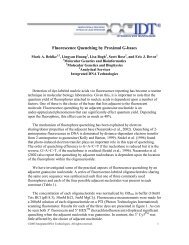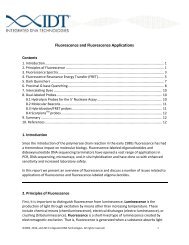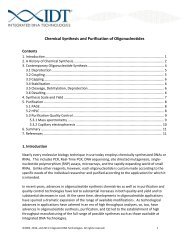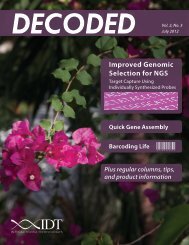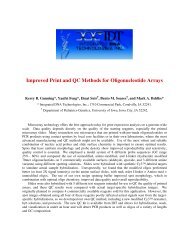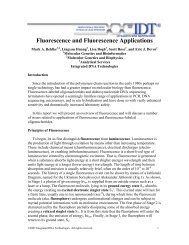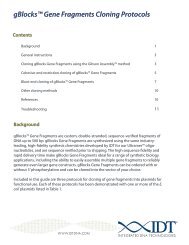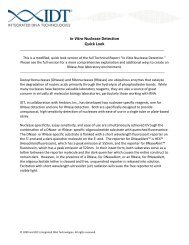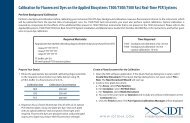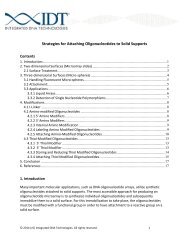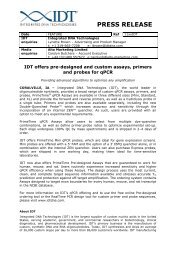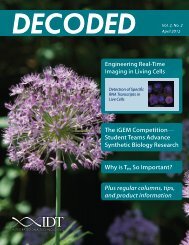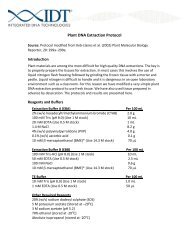5' Nuclease Assays for qPCR - Integrated DNA Technologies
5' Nuclease Assays for qPCR - Integrated DNA Technologies
5' Nuclease Assays for qPCR - Integrated DNA Technologies
Create successful ePaper yourself
Turn your PDF publications into a flip-book with our unique Google optimized e-Paper software.
5’ <strong>Nuclease</strong> <strong>Assays</strong> <strong>for</strong> <strong>qPCR</strong><br />
PrimeTime TM <strong>qPCR</strong> <strong>Assays</strong> offer gold standard per<strong>for</strong>mance, design and configuration<br />
flexibility, and fast turnaround time you have come to expect from the worldwide<br />
leader in custom oligo manufacturing.<br />
The PrimeTime <strong>qPCR</strong> Assay consists of two primers and a hydrolysis probe with<br />
unmatched flexibility. Select from the database of Pre-designed <strong>Assays</strong> <strong>for</strong> human,<br />
mouse, and rat or design a custom Assay. Both are available with choices <strong>for</strong> reporter<br />
and quencher combinations and primer-to-probe ratios to meet experimental<br />
needs. All three components are combined into a single tube and shipped in two to<br />
four business days.<br />
Per<strong>for</strong>mance<br />
• Gold standard per<strong>for</strong>mance – IDT is authorized by Applied Biosystems to provide 5’ nuclease assays.<br />
• PrimeTime <strong>qPCR</strong> <strong>Assays</strong> are guaranteed to provide assay efficiency >90% when using <strong>Assays</strong> generated from<br />
IDT’s Pre-designed Assay collection or the RealTime Design Tool, a commercially available master mix, and<br />
measured over a minimum of four orders of magnitude.<br />
• New Double-Quenched Probes TM , available only at IDT, have both lower background and higher signal than<br />
traditional dye-quencher combinations.<br />
Flexibility<br />
• No more black box assays – complete primer and probe sequences are shared prior to purchase.<br />
• Choose from five different dye/quencher combinations to best fit any instrument or multiplexing need.<br />
• Select a premixed primer/probe ratio from 1:1 to 4:1 to maximize experimental flexibility and facilitate<br />
multiplexing or nontraditional applications.<br />
Af<strong>for</strong>dability<br />
• Paying <strong>for</strong> unused reactions? – The PrimeTime Mini allows large cost savings when analyzing high numbers<br />
of genes across limited samples and is a perfect tool <strong>for</strong> discovery or validation.<br />
• The PrimeTime Standard offers twice as many reactions as competitive products at a lower price.<br />
• Screening thousands of samples? – The PrimeTime XL is priced at a fraction of the cost of the competition.<br />
WWW.IDT<strong>DNA</strong>.COM
PrimeTime ® Technical In<strong>for</strong>mation<br />
Introduction to PrimeTime <strong>qPCR</strong> Assay Technology<br />
PrimeTime <strong>qPCR</strong> <strong>Assays</strong> are 5’ <strong>Nuclease</strong> assays, the gold standard <strong>for</strong> quantitative<br />
gene expression studies. The assay consists of a <strong>for</strong>ward primer, a reverse<br />
primer, and a hydrolysis probe all delivered in a single tube. The oligonucleotide<br />
mixture allows <strong>for</strong> relative or absolute quantification of a target<br />
sequence within a sample. Unlike intercalation dyes, such as SYBR®, the duallabeled<br />
probe allows <strong>for</strong> improved specificity by increasing fluorescence only<br />
when the target sequence is amplified.<br />
During PCR extension, the polymerase cleaves the reporter dye on the 5’ end<br />
of the hybridized probe, separating the dye from the quenching moiety. The<br />
real-time PCR instrumentation detects the fluorescence over a number of cycles<br />
allowing <strong>for</strong> quantitative gene expression measurements.<br />
D<br />
D<br />
Q<br />
Q<br />
The primers and probe hybridize in a sequence-dependent<br />
manner to the complementary <strong>DNA</strong> strand. Because the<br />
probe is intact, the fluorophore and quencher are in close<br />
proximity and the quencher absorbs fluorescence emitted<br />
by the fluor.<br />
The polymerase extends from the primers and begins <strong>DNA</strong><br />
synthesis.<br />
D<br />
Q<br />
The polymerase reaches the probe and the exonuclease<br />
activity of the polymerase cleaves the hybridized probe. As<br />
a result of cleavage, the fluorophore is separated from the<br />
quencher and its fluorescence can be detected.<br />
D<br />
Q<br />
The fluorescence is detected by the real-time instrument<br />
during extension.<br />
These steps are repeated <strong>for</strong> each PCR cycle and allow detection of specific products. With<br />
intercalation dyes, such as SYBR®, primer dimers and non-specific products will also contribute<br />
to fluorescence. In contrast, the 5’ <strong>Nuclease</strong> Assay is specific and fluorescence will<br />
only be detected <strong>for</strong> the <strong>DNA</strong> sequence to which the probe and primers hybridize.<br />
SYBR® is a registered trademark of Molecular Probes, Inc., 29851 Willow Creek Road Eugene, OR 97402
PrimeTime <strong>qPCR</strong> Assay Per<strong>for</strong>mance<br />
Dynamic Range and Sensitivity<br />
To demonstrate the sensitivity of a PrimeTime <strong>qPCR</strong> Assay, IDT tested a dilution series<br />
over six orders of magnitude down to ten copies per reaction. All dilutions tested produced<br />
highly consistent results.<br />
40<br />
CQ<br />
35<br />
30<br />
25<br />
20<br />
Slope = -3.2692<br />
R² = 0.9994<br />
Figure 1. Dynamic range (6 logs) and<br />
10 copy sensitivity. The PrimeTime<br />
Assay was analyzed by utilizing a plasmid<br />
dilution series, and a no template<br />
control. The data shown illustrate<br />
six logs of dynamic range and assay<br />
sensitivity down to 10 copies per<br />
reaction. The efficiency of the assay<br />
calculated from the standard curve is<br />
102.2% with a correlation coefficient<br />
of 0.9994.<br />
15<br />
0 1 2 3 4 5 6 7<br />
Log (Quantity)<br />
PrimeTime Reliability with Commercially Available Master Mixes<br />
IDT recommends the Brilliant II <strong>qPCR</strong> Master Mix from Agilent. The combination of the Mx3005P <strong>qPCR</strong> instrument<br />
and Brilliant II/III <strong>qPCR</strong> Master Mix from Agilent and the PrimeTime <strong>qPCR</strong> <strong>Assays</strong> from IDT provides a fully supported<br />
solution, ideal <strong>for</strong> <strong>qPCR</strong> validation studies. IDT has also tested other master mixes and found that PrimeTime<br />
<strong>qPCR</strong> <strong>Assays</strong> demonstrated efficiency close to 100% across many commercially available master mixes.<br />
<strong>Integrated</strong> <strong>DNA</strong> <strong>Technologies</strong> and Agilent<br />
Competitor A<br />
3 5<br />
A C T B S tandard C urve<br />
4 0<br />
T B P S tandard C urve<br />
3 0<br />
18S S tandard C urve<br />
3 5<br />
B 2M S tandard C urve<br />
3 0<br />
3 5<br />
2 5<br />
3 0<br />
C q Va lue<br />
2 5<br />
2 0<br />
C q Va lue<br />
3 0<br />
2 5<br />
C q Va lue<br />
2 0<br />
1 5<br />
C q Va lue<br />
2 5<br />
2 0<br />
1 5<br />
2 0<br />
1 0<br />
1 5<br />
1 0<br />
-2 .5 -2 -1 .5 -1 -0 .5 0 0 .5 1 1 .5 2 2 .5<br />
Log(S a mple A mount)<br />
1 5<br />
-2 .5 -1 .5 -0 .5 0 .5 1 .5 2 .5<br />
Log(S a mple A mount)<br />
5<br />
-2 .5 -2 -1 .5 -1 -0 .5 0 0 .5 1 1 .5 2<br />
Log(S a mple A mount)<br />
1 0<br />
-2 .5 -2 -1 .5 -1 -0 .5 0 0 .5<br />
Log(S a mple A mount)<br />
F luo r e sce nce (dR n)<br />
8 .5<br />
7 .5<br />
6 .5<br />
5 .5<br />
4 .5<br />
3 .5<br />
2 .5<br />
1 .5<br />
0 .5<br />
-0 .5<br />
Agilent and IDT<br />
Competitor A<br />
1 3 5 7 9 1 1 1 3 1 5 1 7 1 9 2 1 2 3 2 5 2 7 2 9 3 1 3 3 3 5 3 7 3 9<br />
C ycle s<br />
C t (dR n)<br />
Agilent and IDT<br />
Competitor A<br />
3 .3 5 5 *L O G - (X ) + 2 1 .6 2 , Eff. = 9 8 .6 , Rsq = 0.99<br />
3 .6 0 1 *L O G -(X ) + 2 3 .1 3 , Eff. = 8 9 .5 %, Rsq = 0.99<br />
3 2<br />
3 1<br />
3 0<br />
2 9<br />
2 8<br />
2 7<br />
2 6<br />
2 5<br />
2 4<br />
2 3<br />
2 2<br />
2 1<br />
2 0<br />
1 9<br />
1 8<br />
1 7<br />
1 6<br />
1 5<br />
1 4<br />
0 .0 1 0 .1 1 1 0<br />
I nitial Q uantity (nano gr am s)<br />
C a lc u la te d q P C R E ffi c ie n c y C o m p a ris o n ID T a n d<br />
A gile n t + ID T<br />
A gile n t P ro d u c ts vs . Competitor A<br />
C o mp e tito r A<br />
1 1 0 %<br />
1 0 4 %<br />
1 0 2 %<br />
1 0 3 %<br />
9 7 %<br />
9 9 %<br />
9 9 %<br />
9 7 % 9 9 %<br />
1 0 0 %<br />
9 5 %<br />
9 6 %<br />
9 3 %<br />
9 0 % 9 0 % 9 0 %<br />
9 0 % 9 1 %<br />
9 1 %<br />
9 0 %<br />
8 6 %<br />
Figure 2. PrimeTime <strong>qPCR</strong> <strong>Assays</strong> with Brilliant II Master Mix were compared to Competitor A master mix and pre-designed assays across a 10-fold c<strong>DNA</strong> dilution<br />
series (prepared with AffinityScript c<strong>DNA</strong> Synthesis Kit on Human Universal Reference RNA from Agilent) from 100 ng to 0.1 ng run on the ABI 7900HT system<br />
under standard cycling conditions. Top panel: Data illustrate Brilliant II and PrimeTime <strong>qPCR</strong> <strong>Assays</strong> generate C q values 1-2 cycles earlier than the competition,<br />
particularly at lower input amounts. Bottom panel: B2M amplification plots and standard curve are shown along with efficiency comparison <strong>for</strong> assays across 8<br />
targets. In the B2M assay, the Agilent/IDT assay resulted in 1.5x higher fluorescence and detected each standard 1-2 C q earlier than Competitor A. The standard<br />
curve efficiency values are higher <strong>for</strong> 7 of 8 Agilent/IDT assays and on average 8% higher. Note: 5 of the 8 Competitor A assays are at or below 90% efficiency.<br />
A ssay Efficie ncy<br />
8 0 %<br />
7 0 %<br />
6 0 %<br />
5 0 %<br />
1 8 s A C TB B 2 M G A P D H G U S B H P R T P S G 8 TB P 8 Ta r ge t<br />
A ve r a ge<br />
Targe t G e ne<br />
TaqMan® is a registered trademark of Roche Molecular Systems that is licensed exclusively to Applied Biosystems Inc. <strong>for</strong> use in certain non-diagnostic fields. QuantiTect® is a registered<br />
trademark of QIAGEN group. iTaq is a trademark of Bio-Rad Laboratories, Inc. Brilliant® is a registered trademark of Stratagene.
Reproducibility Across Assay Scales<br />
It is critical that the per<strong>for</strong>mance of the Assay remain consistent across scales. IDT tested the Mini, Standard and XL<br />
PrimeTime <strong>Assays</strong> and found reproducibility and precision across all three scales. This attribute allows extension of<br />
research from discovery or validation applications to screening applications.<br />
Gene ID TNFRSF1A PDK1 JAK2 E2F1 TEC<br />
PrimeTime Scale<br />
Mini<br />
Standard<br />
XL<br />
Replicate 1 28.9 24.6 27.5 22.9 29.1<br />
Replicate 2 29.1 24.7 27.5 22.9 29.1<br />
Replicate 3 28.8 24.6 27.5 22.9 29.1<br />
Replicate 1 29.0 24.6 27.3 22.8 29.6<br />
Replicate 2 28.9 24.8 27.3 23.0 29.5<br />
Replicate 3 28.9 24.6 27.5 22.9 29.6<br />
Replicate 1 29.0 24.6 27.5 23.0 29.5<br />
Replicate 2 28.9 24.6 27.5 23.0 29.4<br />
Replicate 3 28.7 24.7 27.6 23.0 29.5<br />
TNFRSF1A PDK1 JAK2 E2F1 TEC<br />
Figure 3. Each reaction contained 50 ng of HeLa cell c<strong>DNA</strong> and the ABI Taqman Gene Expression Master Mix. The c<strong>DNA</strong> was made with oligo dT and<br />
random hexamers using SuperScript II (Invitrogen, Carlsbad, CA). All assays were run in triplicate using the ABI 7900 Real-time PCR instrument under<br />
standard cycling conditions <strong>for</strong> 45 cycles. Each table lists C q values with three replicates each. All three <strong>for</strong>mulations are shown as an overlay. (Top)<br />
Two lots of PrimeTime Mini <strong>qPCR</strong> <strong>Assays</strong> were manufactured <strong>for</strong> five different assays. (Bottom) <strong>Assays</strong> <strong>for</strong> five genes were <strong>for</strong>mulated as PrimeTime<br />
Mini, Standard, and XL <strong>qPCR</strong> <strong>Assays</strong>.<br />
Dye/Quencher Combinations<br />
To demonstrate the per<strong>for</strong>mance of different dye/quencher combinations, IDT tested a dilution series and found robustness<br />
in PCR efficiency and R 2 values across all dye/quencher combinations available.<br />
Dye / Quencher<br />
Combination<br />
FAM TM / Iowa Black® FQ FAM TM / TAMRA HEX TM / Iowa Black® FQ TET TM / Iowa Black® FQ Cy5 TM / Iowa Black® RQ<br />
Amplification<br />
Curve<br />
Standard<br />
Curve<br />
Efficiency 95.7% 95.1% 94.7% 94.5% 98.0%<br />
Correlation<br />
Coefficient (R 2 )<br />
0.999 0.999 0.999 0.999 0.999<br />
Figure 4. Demonstrated Assay Per<strong>for</strong>mance with Multiple Dye Quencher Combinations. A plasmid dilution series of the CSK (c-src tyrosine kinase) Assay<br />
was used to test different dye-quencher combinations. The data illustrate robustness in PCR efficiency and R 2 values across all dye/quencher combinations<br />
available <strong>for</strong> PrimeTime <strong>Assays</strong>. All reactions were run with ABI Gene Expression Master Mix under standard cycling conditions. The first four assays were run<br />
on the ABI 7900 and the final assay (Cy5) was run on the Roche LC480.<br />
FAM, HEX, and TET are trademarks of Applied Biosystems, Inc.
Product Specifications<br />
Reactions<br />
(20 µL)<br />
Estimated<br />
Shipping Time<br />
Probe<br />
(nmoles)<br />
Primers<br />
(nmoles) 1<br />
PrimeTime Mini 100 2-4 business days 0.5 1<br />
PrimeTime Standard 500 2-4 business days 2.5 2.5-10<br />
PrimeTime XL 2500 2-4 business days 12.5 12.5-50<br />
1<br />
The primer/probe ratio may be specified by the customer <strong>for</strong> the PrimeTime Standard and XL <strong>Assays</strong>. The<br />
primer concentration may be 1-4x that of the probe.<br />
• All probes are labeled with a fluorophore at the 5’ end and a quencher at the 3’ end. Double-Quenched Probes also<br />
contain an internal ZEN quencher.<br />
• The product is delivered lyophilized in a single tube containing pre-mixed primers and probe.<br />
• Each assay is made to order with estimated shipping in 2 to 4 business days from order receipt.<br />
• Each oligo undergoes 100% QC by mass spectrometry. All QC results are provided free of charge to the customer<br />
on the IDT website.<br />
Dye/Quencher Combinations<br />
Dye Quencher Mini Standard XL<br />
5’ FAM ZEN/3’ Iowa Black FQ • • •<br />
5’ FAM 3’ TAMRA • •<br />
5’ HEX 3’ Iowa Black FQ • •<br />
5’ TET 3’ Iowa Black FQ • •<br />
5’ Cy5 3’ Iowa Black RQ • •<br />
Instrument Compatibility with Reporter Dyes<br />
ABI 7000<br />
ABI 7300<br />
ABI 7500<br />
ABI 7900<br />
ABI StepOne<br />
ABI StepOne Plus<br />
BioRad CFX384<br />
FAM • • • • • • • • • • • • • • •<br />
TET 0 0 0 • 0 0 0 0 0 0 0 0 0 0 0<br />
HEX 0 0 0 0 0 0 • • • • • • • • •<br />
Cy5 x x • x x x • • • x x • • 0 •<br />
BioRad CFX96<br />
BioRad iCycler<br />
BioRad MiniOpticon<br />
BioRad MyIQ2<br />
BioRad MyIQ5<br />
Roche LC480<br />
Stratagene Mx3000P<br />
Stratagene Mx3005P<br />
supplier provided or recommended reporter dyes<br />
•<br />
0 instrument capable dyes, but may require calibration<br />
x<br />
instrument incapable of supporting
Ordering PrimeTime Pre-designed <strong>Assays</strong><br />
1. www.idtdna.com/order/predesignedassay.aspx<br />
2. Enter the gene name, RefSeq number, or Assay ID.<br />
3. Select the species from mouse, human, or rat.<br />
4. Click on Submit.<br />
5. To sort the results, drag the column that you would like to sort by to the top. Drag more than one<br />
column to the top to further refine the search.<br />
6. Select the Assay you would like to order.<br />
7. Click on the Assay Configuration link to select the size (Mini, Standard, or XL), the dye-quencher<br />
combination, and the primer-to-probe ratio.<br />
8. Click to Add to Order or Add and Checkout button.<br />
Ordering Custom <strong>Assays</strong><br />
The highly flexible RealTime PCR Design Tool allows <strong>for</strong> complete control of design parameters, such as melting temperature<br />
targets, amplicon length, and key master mix ingredient concentrations. Prior to purchase, the tool provides<br />
the customer with details about the assay that have been previously hidden by competitors; these include the primer<br />
and probe locations, amplicon length, melting temperature and, most importantly, actual primer and probe sequences.<br />
Custom PrimeTime <strong>qPCR</strong> Assay order steps:<br />
1. Enter RefSeq accession numbers or gene sequences. Look up an accession number using the RefSeq lookup tool.<br />
Click Design Assay to continue.<br />
2. Select the assay location such as the entire coding region or specific exons. Click Design Assay to continue.<br />
3. The tool will design multiple assays across different exons. Select the set you want to order (set 1 is most recommended).<br />
4. Review primer and probe sequences and add the Assay to the order.<br />
5. Select primer-to-probe ratios and dye/quencher combinations.<br />
Use of this product is covered by one or more of the following US patents and corresponding patent claims outside the US: 5,538,848, 5,723,591, 5,876,930, 6,030,787, 6,258,569, and 5,804,375<br />
(claims 1-12 only). The purchase of this product includes a limited, non-transferable immunity from suit under the <strong>for</strong>egoing patent claims <strong>for</strong> using only this amount of product <strong>for</strong> the purchaser’s<br />
own internal research. Except under separate license rights available from Applied Biosystems, no right under any other patent claim, or to per<strong>for</strong>m commercial services of any kind,<br />
including without limitation reporting the results of purchaser’s activities <strong>for</strong> a fee or other commercial consideration, or to sublicense, repackage with other products, or resell in any <strong>for</strong>m, is<br />
conveyed expressly, by implication, or by estoppel. This product is <strong>for</strong> research use only. Diagnostic uses under Roche patents require a separate license from Roche. Further in<strong>for</strong>mation on<br />
purchasing licenses may be obtained from the Director of Licensing, Applied Biosystems, 850 Lincoln Centre Drive, Foster City, Cali<strong>for</strong>nia 94404, USA. Certain PrimeTime® <strong>Assays</strong> may contain<br />
one or more proprietary dyes that are sold subject to separate limited licenses. Cy, is a registered trademark of GE HealthCare, and when applicable, the purchaser obtains a limited nonexclusive<br />
sublicense under U.S Patent Nos. 5 556 959 and 5 808 044 and <strong>for</strong>eign equivalent patents and other <strong>for</strong>eign and U.S counterpart applications to use the Product to per<strong>for</strong>m research.<br />
NO OTHER LICENSE IS GRANTED EXPRESSLY, IMPLIEDLY OR BY ESTOPPEL. Use of the Product <strong>for</strong> commercial purposes is strictly prohibited without written permission from GE HealthCare. Iowa<br />
Black® is a registered trademark of IDT. The purchase of this product includes a limited non-exclusive sublicense under U.S. Patent Nos. 7 439 341, 7 476 735 and 7 605 243 and U.S counterpart<br />
applications <strong>for</strong> use in the purchaser’s internal research applications only.<br />
http://www.idtdna.com/catalog/Usage/Page1.aspx<br />
©2011 <strong>Integrated</strong> <strong>DNA</strong> <strong>Technologies</strong>



